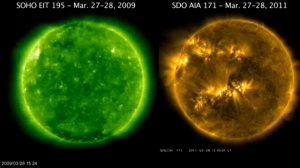
One of the maverick solar physicists that changed the way we look at the behavior of the Sun says that we may already have reached the peak of the current solar cycle—bringing with it increased chances for stronger solar storms—as signaled by a complete flip of the Sun’s magnetic field.
The current solar cycle, cycle 25, got underway in December 2019 and was originally predicted to be a mild season that would reach its maximum sometime next year. However, this cycle proved to be much more active than predicted, prompting NOAA’s Space Weather Prediction Center (SWPC) to revise their official forecast in October 2023 for this cycle’s solar maximum to arrive sometime between January and October of this year.
Predicting the timing of this cycle’s solar maximum has been a bit more difficult this time around, due to an atypical fluctuation in the rate of solar activity: December 2023 saw a sharp peak in sunspot numbers, followed by an unusually quiet January before rebounding in February with three strong X-class solar flares.
Although forecasting when the next solar maximum might occur has been more problematic than usual, one of the physicists that accurately predicted that solar cycle 25 would not only be more active but also peak earlier than expected, National Center for Atmospheric Research (NCAR) Deputy Director Scott McIntosh, thinks that we’re already in the midst of the current cycle’s crescendo.
“I think that we are definitely entering that phase of activity,” McIntosh predicts. Unfortunately, it is difficult to determine if solar activity has peaked using the traditional method of marking changes in the Sun’s cycles—by counting the number of sunspots—until after that activity has actually started to decline. However, McIntosh says that there is a more immediate way to tell whether or not solar activity has peaked.
The basis of the thus-far accurate predictions being made by McIntosh’s team is the observation of the magnetic bands that migrate from the Sun’s polar regions toward the equator; when they meet at the equator these bands, being of opposite polarity, cancel each other out in what McIntosh calls a “termination event”.
While these termination events mark the lull of a solar minimum, the solar maximum is marked by a flip in the polarity of the magnetic fields at the poles—north becoming south and south becoming north—during which there is a brief period where the strength of the polar magnetic fields disappears altogether, providing a more immediate way of determining if activity on the Sun’s surface is about to start to decline.
According to McIntosh the Sun has been in such a state for a number of months, with the polar field strength “hovering around zero,” meaning the solar maximum may very well be underway as we speak.
Although we should expect to see a continuation of numerous solar flares and coronal mass ejections over the next year or so, it’s important to remember that the recent increase in solar activity is still very mild compared to its peak during cycle 19, of which occurred between 1954 and 1964. Solar activity has steadily declined since then, and appears to have bottomed out in the most recent cycle, solar cycle 24, between 2008 and 2019.
Regardless, it would be unwise to let our guard down, as the most intense geomagnetic storm in recorded history, the 1859 Carrington Event, occurred during an otherwise-average solar cycle, an event that, if it were to happen today, would be devastating to our modern electrical grid. Whitley outlines the danger presented by solar storms of that magnitude—and what needs to be done to weather such a storm—in his 2012 ebook Solar Flares: What You Need to Know.
Subscribers, to watch the subscriber version of the video, first log in then click on Dreamland Subscriber-Only Video Podcast link.
I have a song for our beautiful sun that came to mind while reading…LATEST NEWS. For the better or worse it is our life giving and life taking STAR.
The Beatles – Here Comes The Sun (2019 Mix) (youtube.com)
https://www.youtube.com/watch?v=KQetemT1sWc
When I read this I think back to what it must have been like to live in Pompeii before the blast.